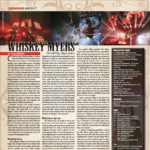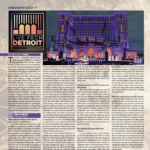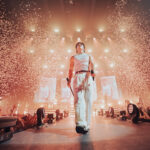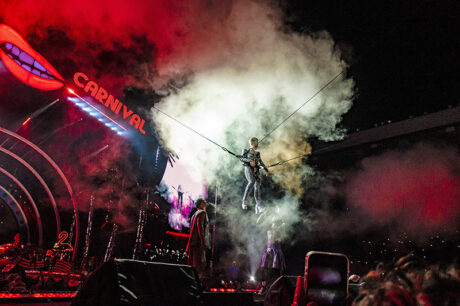
It’s been a busy few months for P!nk. She just wrapped up her arena tour, Trustfall, which came right on the heels of her Summer Carnival stadium tour. Working with P!Nk since 2005, the ever innovative Baz Halpin, CEO & Founder of Silent House, was back as the tour’s Creative Director and Producer. Together the artist and designer have always created performances that soar high, quite literally in the case of P!nk. Halpin shares some insights with PLSN of the high-flying design for the Summer Carnival shows.
BAZ HALPIN
Creative Director and Producer
Tell us a bit of how this tour developed.
After the Funhouse arena tour in 2009, which was wildly successful, P!nk did a stadium tour in Europe during the summer called The Funhouse Summer Carnival. It was born out of that Funhouse tour, which had a kind of freaky circus theme. Mark Fisher was the set designer on that—Mark was who first introduced me to Roger [Davies, P!nk’s manager] and . For this tour, Roger had the idea to do this spinoff of the Funhouse tour in stadiums. The idea of Summer Carnival was that it was a summer party; just a good time. So, in 2023, this tour went out as P!nk’s Summer Carnival. It was less theatrical, more of a traditional rock show, but it still has elements of dance, and it also has the big death-defying aerial stunts. Then when we went into arenas, we modified it and it became the Trustfall tour.
What are some of the key elements of the design and how do they support the narrative?
Well, it’s always about what’s the aerial spectacular that she can pull off that hasn’t been done before. Also, P!nk has this iconic snarl that she does in a lot of her photographs. So, as part of the Summer Carnival sign that sits on top of the stage, we turned her snarl into a giant mouth that TAIT built. She appears in the mouth for the opening song. And she jumps! That’s how she gets down to the stage. She enters the show with this giant 60’ trustfall, that gets her down to the stage. That’s our signature aerial moment.
Then outside of that, we have a silks moment that she does over the audience. The stage has a long thrust and a T at the end that gets her out into the crowd. She does a silk duet there, and then she does the 360 flying gag. It is great. This show is really big, bright, and colorful. It’s almost like an ‘80s themed beach party. All the colors are very neon—hot pinks, yellows, oranges, and greens. We embrace the ludicrous, we embrace the silly. It is just a good time. We have dancers who are zipping around the stage on giant pink flamingo scooters. There are water fights and beach balls. There’s a lot of things that are really whimsical and fun and goofy, because she has an incredible sense of humor. A part of the whole ethos of the Summer Carnival is to keep it light, keep it fun.
Like the mirror-covered palm trees. Those are great.
The palm trees that are covered with mirrors are all inflatables that were built by Matthew [Whitehead] at Airworks Inflatables. They really are fantastic; some of them are 50’ tall. I called and said, ‘Matthew I want to make an inflatable mirrorball palm tree.’ He immediately responded, ‘no problem’. He’s the best. Again, they add the fun aspect, where you can really feel like it’s the whole stadium themed out. You know when you walk in like you’re in for something fun. It’s something that’s not taking itself too seriously. We also have inflatable, mirror-covered beach balls, and a giant studded ice cream cone drum riser. The cone itself is an inflatable; the melted ice cream part is polycarb. It’s a lot of fun.

What are the arches framing the stage made from and how are they lit?
Those are aluminum frames built by DAS with LED strip lighting just to give the stage its own definition. They help define the dimensions of the stage. That is something that when we moved from stadiums to arenas we carried across. We carried across a lot of the familiar architecture. Vincent Richards of Silent House worked with me on the scenery. It a looks great and works for the shows so well.
Talk about the trampoline/staircase structure.
I came across this trampoline artist that did a lot of gallery and performance art installations. He just had this amazingly, sort of, effortless and airy way that he used a trampoline, and it just made it incredibly beautiful. So, we teamed him and P!nk together and built this little duet for Graham Norton to introduce ‘Trustfall.’ She always likes to do things that people haven’t really done before. I don’t think anybody’s ever really embraced trampolines on a tour because really, it’s quite difficult. To do the stuff that we have done, like where they’re dropping from height, you need to have a lot of a very big structure to do that. Everything is hinged around it.
We went to Circus Center in Las Vegas and did auditions for trampoline artists as well as other gymnastic scenarios. Part of the permanent trampoline installation they had there had walls at perpendicular angles, which we thought added a unique dimension because you want to be able to see a trampoline from two angles, so both perpendicular and parallel to the audience. So that’s where we came up with this double trampoline idea, and then building the stairs in and the platform at the back. That is because it’s going to be on stage for so long we wanted to be able to use it as an additional scenic element that would give us levels that we could use for more than just one song. Then we also knew it was going to be in front of the LED screen, so we decided to make it transparent. We used a clear Lexan that we applied an adhesive, pink-colored film. That worked out really well; when we weren’t using it, it disappeared. When we were using it, it was very present and very effective. We used it in a couple of songs and use it more just as a fun apparatus where they can really showcase their skills.
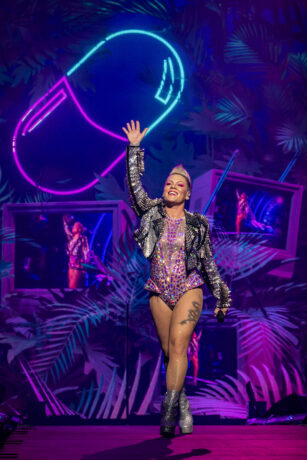
Tell us about how lighting is then layered into your visual design.
There’s not a ton. I always try to make, as much as possible, make scenery self-illuminate. Because in arenas and stadiums, you have to factor that sometimes it’s hard to just rely on external light to illuminate scenic pieces. So, everything has some form of self-illumination, whether it’s Neon Flex or internal LED cove lighting. That helps us, the ribs all self-illuminate. The LED self-lighting is complemented by some external lighting, but most of the lighting rig is there to light the dancers, the performance, the aerial work, and then really create a very musically dynamic show.
P!nk is a chameleon in terms of what she can do. She’s a great dancer, she’s a great pop artist. She’s an incredible rock performer, but she also has an amazingly powerful, soulful voice. So, you have to have all the functionality of lighting a pop show where you see all the actions very clearly directed. Then you have to have the power and the energy for a rock show, and then also be able to strip it back and have those more intimate moments. We try to capture all three of those needs with the arrangement of the lights. That is why [Lighting Programmer] Dan Norman was really a fantastic addition to the show. I’d worked with Dan before, but this was the first time that we really spent a considerable amount of time together, and he really brought a great perspective to the process. Also, we were very fortunate to have Steve “Six” Schwind back for the tour as the Lighting Director.
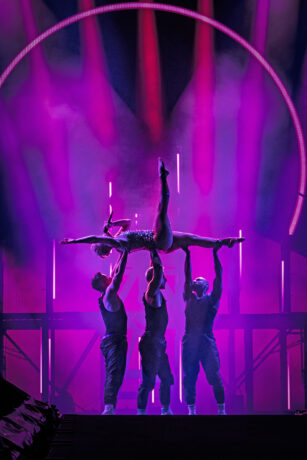
What were some of your key gear choices, and how do they support your design?
We have [Robe] MegaPointes that went around the video arch and iFORTES and BMFLs as well as Spiiders, which have become workhorse fixtures for us. We also had [Elation] Excaliburs and [TMB Solaris] Flares, which are always a staple. We like bright, powerful LED fixtures. Like most shows these days, we use predominantly LED-driven fixtures. We’ve got enough Flares and enough strobes to give us the power because we have to think about the beams when you’re in an outdoor environment and what you do when it’s still daylight. How you program it, knowing that the during the first half of the tour, you’re not going to get dark until the third to last song. But then towards the end of the tour, when you get into North America in September and October, you’re going to be dark for most of the show. That’s something you always have to consider. So, we chose fixtures that when you could see the beam were great, but also when you couldn’t see the beam, we could build looks that were strong enough that would fill up the frame with points of light, or lenses that would help to not just make it look like a gray, blackhole, which is oftentimes what happens. We wanted it to be a colorful show. It was always to be bright, colorful, uplifting, and just fun. I think in the fixtures that we chose we really felt we were able to get strong, powerful beams with great colors that really could pop, especially some of the more neon types of colors like greens and oranges that can sometimes tough.
What were you using for your video screens?
The upstage screen is Saco S9 from Solotech, the vendor for lighting and video. The I-Mag screens are ROE CB5 panels. We had disguise media servers and Manny Conde was the Video Programmer. Gabriel Coutu-Dumont and Silent Partners produced the video content, and Charles Alves was the Video Director. It was a good team. I-Mag is so important these days. So critical. The demand from artists for high quality, considered, well thought out, and scripted I-Mag is more than ever. With all these different shaped screens that us designers come up, where we’ll give them portrait and landscape that we want them to shoot at the same time, with different camera pips on each one, and then add a Notch effect, it’s very complicated nowadays. It is not how we did I-Mag 20 years ago, where it was four cameras and two Fast-Fold projection screens and just point the cameras at the artists.
Today, the video directors really have to be directors. That has to be their sole discipline, and a lot is expected from them. They have to be great multi-cam directors, but they also have to be technologists. They have to understand how Notch works. They have to understand how to frame within these ridiculous scenarios that we design and create. Then they have to help educate because they get young cameramen, or maybe they’re an LED tech, or a projectionist, or a truck driver that has to go do a camera. So, now you’ve got to educate these guys on how to frame shots not only for a 16:9 ratio, but now for these very difficult canvases. The job of a Screens Director on a tour has really become a very niche and specialized skillset.
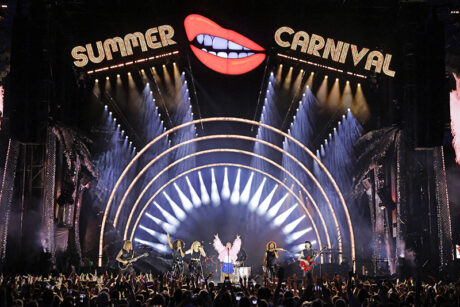
If another designer saw this show, what’s something they might find interesting about this design?
It’s uncomplicated visually. It’s complicated mechanically and technically. The goal with this was to be big, bright, fun, goofy, colorful. The video content, the way everything’s tied together with these sort of summer motifs; everything’s got a P!nk edge to it. P!nk’s very punk rock, so everything’s a little bit punk rock. We’ve got the punk studs on the ice cream cone. With the video content, especially, a lot of the elements that we use, are twists on a familiar thing. You’ll see a smiley face that’s got tattoos and pointed teeth and a watermelon with a face, but the mouth is a zipper from a leather jacket. It’s all kind of fun, goofy stuff. It’s escapism. Like I said, it’s not particularly complicated visually. But it’s complicated mechanically and technically. Getting all the automation, the fly tracks, the way for her to appear in the mouth. Figuring out how do we get her to appear in the mouth in a stadium where you’re starting the show in daylight, and you can see the whole stage; that was difficult. How do we get multiple aerial pieces to pass by each other in the same plane? That was really difficult. But would a person who sees the show recognize that? No, because we’ve done everything to make sure that you don’t notice those things, and to make sure that everything moves flawlessly.
We have gotten incredibly good on P!nk at dealing with all those very difficult technical things. The rigging team has been together for a long time under the direction of Gabe Wood. He and I have worked together on countless things. I am proud to think that Gabe and I together have pushed circus performing in concert touring to new heights. There were other artists that would incorporate silks, and would hire an aerialist, but then P!nk turned that into braids, duets, trios, quads, 360 flying harnesses, slip rings, and porting. She changed the game; brought it to a whole other level. With every evolution that she wanted to do, we had to figure out how you would do that. So as that touring family grew between TAIT, Gabe, and me, we built out all these things. We have a lot of years of knowledge of problem solving these things and have a good sense of the requirements and how to go about doing it. Also, TAIT acquiring all these flying companies and bringing that all under control of Navigator, have created an incredibly robust system that allows you to do these more crazy things, safely. We have an incredible safety record because we have an incredible team that ensures we can do these death-defying things. The audience just thinks they happen and they’re easy, but, of course, they really are incredibly complicated. So, really P!Nk’s Summer Carnival is a very complicated, uncomplicated looking fun show!
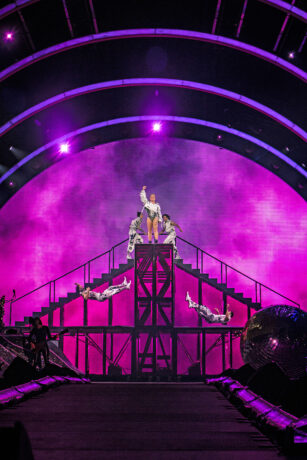
VENDOR VIEW
LEE MORO
Senior VP Live Production, Solotech
It’s amazing to see what Baz and the whole Silent House team do, the way they put a project together from beginning to end. They start with a strong concept, they draw it out, and they are always thinking about the show overall, with all the details thought through. It was great to see this one come to life. She’s such an incredible artist and she has such a strong vision, she’s so dedicated to her craft. That is why her show is amazing and fun, and it’s all ages that are at her shows; all demographics. It’s great to see the positivity she puts out there and our working with Baz and Silent House on the show has been just as positive. It’s always great to be part of making their visions come to life, providing all the nuts and bolts of it. You know some shows rely on the whiz-bang technology, but this is basically a well put together show design with a great artist and it is amazing. You didn’t need some new flashy thing. It’s just a great, entertaining show. And, of course, working with Malcolm Weldon [production manager] on this tour. You can’t say enough about the guy, the amazing career that he’s had, the honor of the trust he puts in our Solotech team. Everybody wants to work with Malcolm. There’s not many that are on his level. He’s such a great person as well. I can’t speak highly enough about the guy. We are all proud that as Solotech we’ve proven ourselves with her as an artist, with Malcolm himself, and of course with Baz and Silent House. That there’s just trust and we all work together. It’s a partnership we certainly value being part of.
EAMONN McCULLAGH
Sr. Director Project Management, Solotech
I love working with all those guys. Malcolm’s awesome all the time. And Baz and his team, our main contact for this tour was Vincent Richards over at Silent House, they are all great. It went really smoothly. You know, I think, with this being a global tour, Solotech having a presence in the UK where they started let them pivot pretty quickly when they decided that they wanted to take a lot more from Europe to America than they had originally thought. The timeframe between the last show in Europe and the first show in America was about six, seven days. Having Solotech as a vendor, with a presence in both places, really helped them do that. It’s just been a really fun project to work on. I’m glad it’s continuing on and we’re going to get to do almost another year with it and keep working with such a great team.
The colorful, fun-filled party continues as P!nk will be bringing her Summer Carnival back to summer in Australia in February 2024 and continue into Europe June through July.
